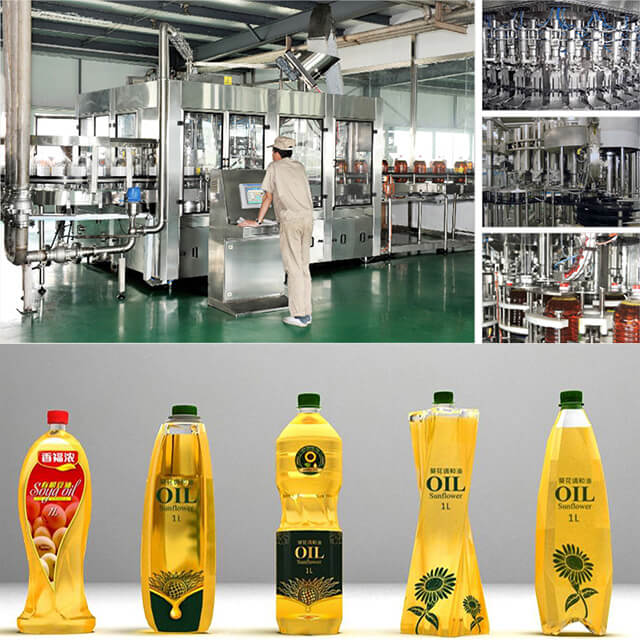News
Site Editor
 Site
/uploads/image/6454bbd2e50a2.png
Maintaining a weigh type oil filling machine plays a vital role in ensuring its efficiency and accuracy. Regular upkeep helps you avoid costly downtime and extends the machine's lifespan.
Site
/uploads/image/6454bbd2e50a2.png
Maintaining a weigh type oil filling machine plays a vital role in ensuring its efficiency and accuracy. Regular upkeep helps you avoid costly downtime and extends the machine's lifespan.
How to Maintain and Troubleshoot Weigh Type Oil Filling Machines
Views: 1124
Author: Site Editor
Publish Time: 2025-01-20
Origin: Site
Maintaining a weigh type oil filling machine plays a vital role in ensuring its efficiency and accuracy. Regular upkeep helps you avoid costly downtime and extends the machine's lifespan. Neglecting maintenance can lead to frequent breakdowns and reduced productivity. Troubleshooting issues promptly ensures smooth operations and prevents minor problems from escalating. By focusing on both maintenance and troubleshooting, you can maximize the machine's performance and reliability over time.

Maintenance for Weigh Type Oil Filling Machines
Daily Maintenance Tasks
You should inspect your weigh type oil filling machine every day for visible wear and tear. Look closely at components like nozzles, belts, and seals. Early detection of damage prevents costly repairs later. Cleaning the machine daily is equally important. Oil residue can build up quickly, leading to clogs or reduced efficiency. Use a soft cloth or manufacturer-recommended cleaning agents to remove residue from surfaces. Always check the alignment of the filling nozzles and conveyor systems. Misaligned parts can cause uneven filling or delays in production.
Monthly Maintenance Tasks
Every month, lubricate the moving parts of your weigh type oil filling machine. Use lubricants recommended by the manufacturer to ensure smooth operation. Testing and calibrating the load cell is another critical task. Accurate weight measurements depend on a properly calibrated load cell. Inspect seals, gaskets, and O-rings for signs of wear or damage. Replacing these small components on time can prevent leaks and maintain the machine's efficiency.
Yearly Maintenance Tasks
Once a year, conduct a thorough inspection of all mechanical and electrical components. This includes checking the wiring, sensors, and load cell connections. Replace worn-out parts like nozzles or belts to avoid unexpected failures during operation. Updating the machine's software or firmware is also essential. New updates often improve performance and fix bugs, ensuring your weigh type oil filling machine operates at its best.
Regular maintenance keeps your machine running smoothly and extends its lifespan. By following these daily, monthly, and yearly tasks, you can ensure optimal performance and reduce downtime.
Troubleshooting Common Issues in Weigh Type Oil Filling Machines
Mechanical Issues
Nozzle blockages or leaks can disrupt the filling process. You should clean the nozzles regularly to remove any oil residue. If cleaning does not resolve the issue, replace the nozzles to restore proper functionality.
Conveyor belt misalignment is another common problem. Misaligned belts can cause delays or uneven filling. Adjust the belt alignment to ensure smooth operation.
Inconsistent filling often results from worn-out seals or gaskets. Inspect these components and replace them as needed to maintain accuracy.
Electrical Issues
Sensor malfunctions can lead to errors in the filling process. Check the sensors for dirt or damage and clean or replace them if necessary.
Faulty wiring or loose electrical connections may also cause disruptions. Inspect the wiring and connections, replacing any damaged parts to prevent further issues.
If you encounter PLC programming errors, consult the manufacturer or a qualified technician. They can help you resolve the problem and restore the machine's performance.
Operational Issues
Bottle jamming in the system can slow down production. Identify the cause of the jam and remove any obstructions. Regularly inspect the system to prevent future occurrences.
Weight discrepancies in filled containers often indicate a calibration issue. Recalibrate the load cell to ensure accurate measurements.
Problems with the capping mechanism, such as misalignment or wear, can also affect efficiency. Adjust or replace the capping components to keep the machine running smoothly.
Troubleshooting these common issues promptly ensures your weigh type oil filling machine operates efficiently. Regular inspections and timely repairs can prevent minor problems from escalating into major disruptions.
Tips for Long-Term Efficiency of Weigh Type Oil Filling Machines
Follow Manufacturer Guidelines
Using the right spare parts and consumables is essential for keeping your weigh type oil filling machine in top condition. Always choose components recommended by the filling machine manufacturer. These parts are designed to work seamlessly with your machine, reducing the risk of malfunctions. Following the suggested maintenance schedule is equally important. Regularly performing the tasks outlined in the manual ensures optimal performance and prevents unexpected breakdowns.
Train Operators and Technicians
Proper training for operators and technicians is a key factor in maintaining efficiency. Provide regular sessions to teach them how to operate and troubleshoot the machine. This helps them handle minor issues without delay. Make sure they understand safety protocols and best practices. A well-trained team minimizes errors and ensures smooth operations, even during high-demand periods.
Monitor Performance Metrics
Tracking performance metrics gives you valuable insights into your machine’s efficiency. Monitor output, downtime, and maintenance history. This data helps you identify patterns and address potential issues before they escalate. Use the information to schedule proactive maintenance and upgrades. Staying ahead of problems reduces downtime and extends the lifespan of your weigh type oil filling machine.
Consistently following these tips will help you maintain the efficiency and reliability of your machine. A proactive approach ensures smooth operations and maximizes productivity over time.
Regular maintenance and effective troubleshooting are essential for keeping your weigh type oil filling machine in peak condition. By following best practices, you reduce downtime, improve filling accuracy, and extend the machine’s lifespan. These steps also help you avoid costly repairs and maintain consistent production. Implementing the actionable tips provided ensures your machine operates efficiently and reliably. Take a proactive approach to care for your equipment, and you’ll maximize its performance while minimizing disruptions. Start applying these strategies today to achieve long-term success with your filling operations.












